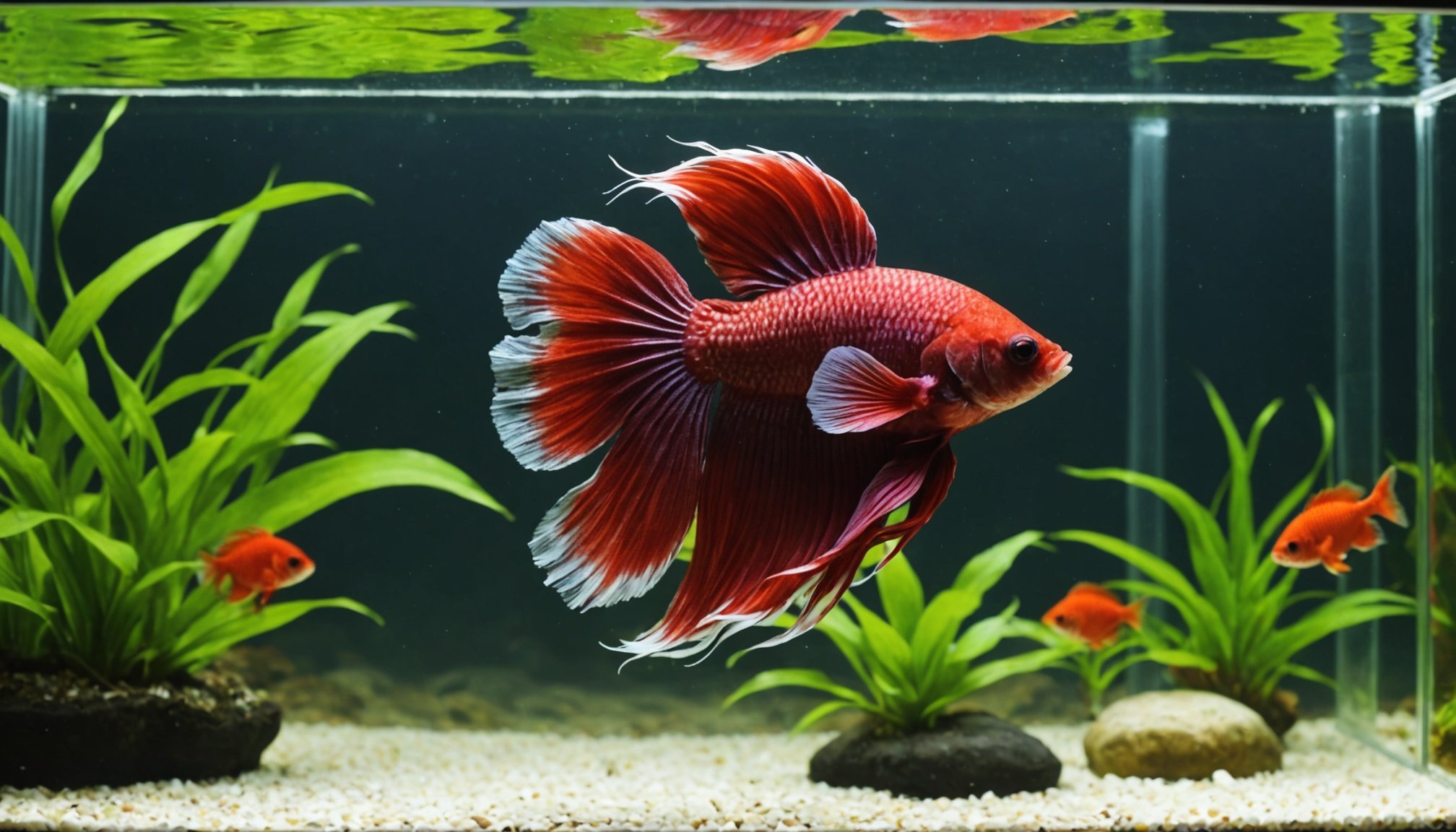Crafting Your Ideal Tropical Betta Fish Aquarium: A Comprehensive Guide
If you’re enthusiastic about creating a thriving and beautiful tropical betta fish aquarium, you’re in the right place. This guide will walk you through the essential factors to ensure your betta fish lives a happy, healthy life in its new aquatic home.
Choosing the Right Tank Size
When it comes to housing your betta fish, the tank size is crucial. Here’s why:
Also read : Essential uk wildflowers for honeybee health: your ultimate guide to nutritional boosts
Why Bigger is Better
While it might be tempting to keep your betta in a small tank, it’s important to remember that these fish need space to thrive. A minimum tank size of 5 gallons is highly recommended for a single betta fish. Larger tanks offer better water quality and stability, which are vital for the health of your fish[4].
Table: Tank Size Comparison
| Tank Size | Pros | Cons |
|---|---|---|
| Less than 5 gallons | Compact, easy to set up | Poor water quality, unstable conditions, higher maintenance |
| 5-10 gallons | Better water stability, easier maintenance | More space required, higher initial cost |
| 10+ gallons | Excellent water quality, stable conditions, plenty of space for plants and decorations | Large space requirement, higher cost, more complex setup |
Practical Advice
If you’re new to aquarium keeping, starting with a 5-gallon tank is a great way to ensure you can provide the best environment for your betta. Remember, the larger the tank, the easier it is to maintain stable water conditions.
Have you seen this : How can you enrich the habitat of your pet tarantula?
Setting Up Your Aquarium
Setting up your aquarium is an exciting part of the process, but it requires careful planning and execution.
Selecting the Right Equipment
Here are some essential items you’ll need:
- Filter: A good filter helps maintain clean and healthy water. For a betta tank, a low-flow filter is best to avoid stressing your fish[4].
- Heater: Tropical fish, including betta fish, thrive in heated water. A heater will help you maintain a consistent water temperature between 76°F and 82°F (24°C to 28°C)[3].
- Lighting: Proper lighting is crucial for both the fish and the plants. LED lights are a popular choice due to their energy efficiency and adjustable color settings.
- Gravel and Decorations: Choose gravel and decorations that are safe for your fish. River cobbles and branching aquarium wood are excellent choices for creating a natural environment[1].
Hardscaping and Aquascaping
Hardscaping involves using rocks, wood, and other materials to create the structure of your aquarium. Here are some tips:
- Use Natural Materials: River cobbles and branching aquarium wood can create a beautiful and natural environment for your betta.
- Add Plants: Plants like Anubias nana, Java fern, and Limnophila heterophylla are great for betta tanks. They provide shelter, improve water quality, and add aesthetic appeal[1].
Water Parameters and Maintenance
Maintaining the right water parameters is critical for the health of your betta fish.
Key Water Parameters
Here are the key parameters to monitor:
- Water Temperature: Keep the temperature between 76°F and 82°F (24°C to 28°C).
- pH Levels: Betta fish prefer slightly acidic to neutral pH levels, between 6.5 and 7.5.
- Water Hardness: Soft to moderately hard water is best for betta fish.
- Ammonia and Nitrite Levels: These should be zero. Regular water changes and a well-established filter will help achieve this[4].
Regular Maintenance
Regular maintenance is essential to keep your aquarium healthy:
- Water Changes: Perform small, regular water changes (about 10-20% every week) to maintain water quality.
- Water Testing: Test your water frequently to ensure the parameters are within the safe range for your betta.
- Cleaning: Clean the gravel and decorations regularly to prevent the buildup of debris.
The Role of Aquatic Plants
Aquatic plants are not just decorative; they play a crucial role in maintaining a healthy aquarium.
Benefits of Aquatic Plants
Here are some benefits of including plants in your tank:
- Oxygen Production: Plants produce oxygen, which is essential for your fish.
- Water Purification: Plants help in purifying the water by absorbing excess nutrients and toxins.
- Shelter and Hiding Places: Plants provide shelter and hiding places for your betta, reducing stress.
Recommended Plants for Betta Tanks
- Anubias nana: A hardy and low-maintenance plant that thrives in low-light conditions.
- Java fern (Microsorum pteropus): A versatile plant that can be attached to rocks or driftwood.
- Limnophila heterophylla: A fast-growing plant that helps in maintaining good water quality[1].
Incorporating Botanicals
Botanicals, such as leaves and branches, can add a natural touch to your aquarium and provide several benefits.
Benefits of Botanicals
Here’s why you should consider adding botanicals:
- Natural Habitat Replication: Botanicals help in replicating the natural habitat of your betta, making them feel more at home.
- Tannins and Water Color: Certain botanicals like catappa leaves and alder cones release tannins, which can tint the water and create a more natural environment[2].
How to Use Botanicals
Here’s a step-by-step guide to using botanicals:
- Choose the Right Botanicals: Opt for materials like magnolia leaves, alder cones, and catappa leaves.
- Prepare the Botanicals: Boil the botanicals before adding them to the tank to remove any impurities.
- Add to the Tank: Place the prepared botanicals in the tank, ensuring they are secure and won’t cause any harm to your fish[2].
Feeding and Care
Feeding and caring for your betta fish is a critical aspect of maintaining a healthy aquarium.
Feeding Your Betta
Here are some tips on feeding your betta:
- Variety is Key: Provide a varied diet that includes high-quality commercial betta pellets, live or frozen foods like brine shrimp, and occasional treats.
- Feed Sparingly: Betta fish have small stomachs, so feed them sparingly to avoid overfeeding.
- Avoid Overfeeding: Overfeeding can lead to poor water quality and health issues for your fish.
Additional Care Tips
- Monitor Health: Regularly check your betta for signs of illness or stress.
- Provide Hiding Places: Ensure your tank has enough hiding places to reduce stress.
- Maintain Water Conditions: Regularly test and adjust the water parameters to ensure they are within the safe range for your betta.
Creating a Stress-Free Environment
Creating a stress-free environment is crucial for the well-being of your betta fish.
Avoiding Stressors
Here are some common stressors to avoid:
- Aggressive Tankmates: Betta fish, especially the Siamese fighting fish (Betta splendens), are known to be aggressive. Keeping them alone is usually the best option.
- Poor Water Quality: Regular water changes and proper filtration can help maintain good water quality.
- Inadequate Hiding Places: Ensure your tank has enough plants, rocks, and other decorations to provide hiding places.
Encouraging Natural Behavior
Here’s how you can encourage natural behavior in your betta:
- Bubble Nest: Betta fish are known to build bubble nests. Providing a peaceful environment with plenty of hiding places can encourage this natural behavior.
- Natural Lighting: Mimic natural day-night cycles with your lighting to help your betta feel more at home.
Creating an ideal tropical betta fish aquarium is a rewarding experience that requires careful planning, regular maintenance, and a deep understanding of the needs of your fish. Here are some final tips to keep in mind:
- Research Thoroughly: Always research the specific needs of your fish species before setting up your aquarium.
- Be Patient: Setting up a successful aquarium takes time, so be patient and enjoy the process.
- Seek Community: Joining aquarium communities or forums can provide valuable insights and support.
By following these guidelines, you can create a thriving and beautiful tropical betta fish aquarium that will bring joy and tranquility to your home.
Additional Resources
For more detailed guides and creative ideas, you can explore various online resources and communities dedicated to aquarium keeping. Here are a few recommendations:
- YouTube Channels: Channels like the one mentioned in the video on setting up a simple betta fish aquarium offer practical and visually engaging guides[1].
- Aquarium Forums: Joining forums or communities like Betta Botanicals can provide you with a wealth of information and support from experienced aquarists[2].
By combining these resources with the tips provided here, you’ll be well on your way to crafting your ideal tropical betta fish aquarium. Happy aquarium keeping











